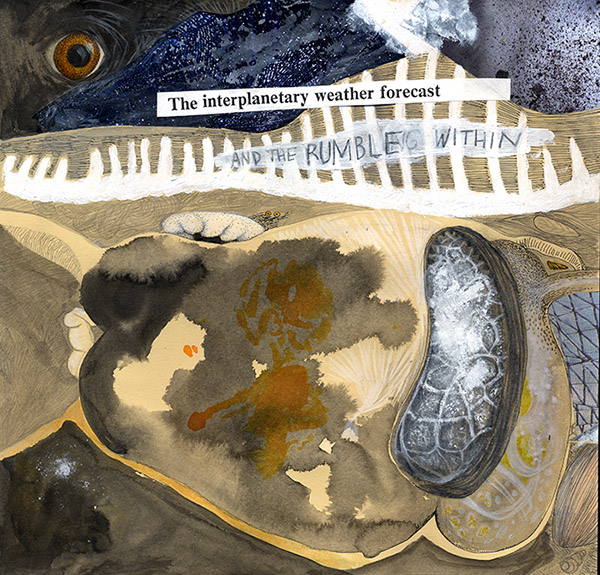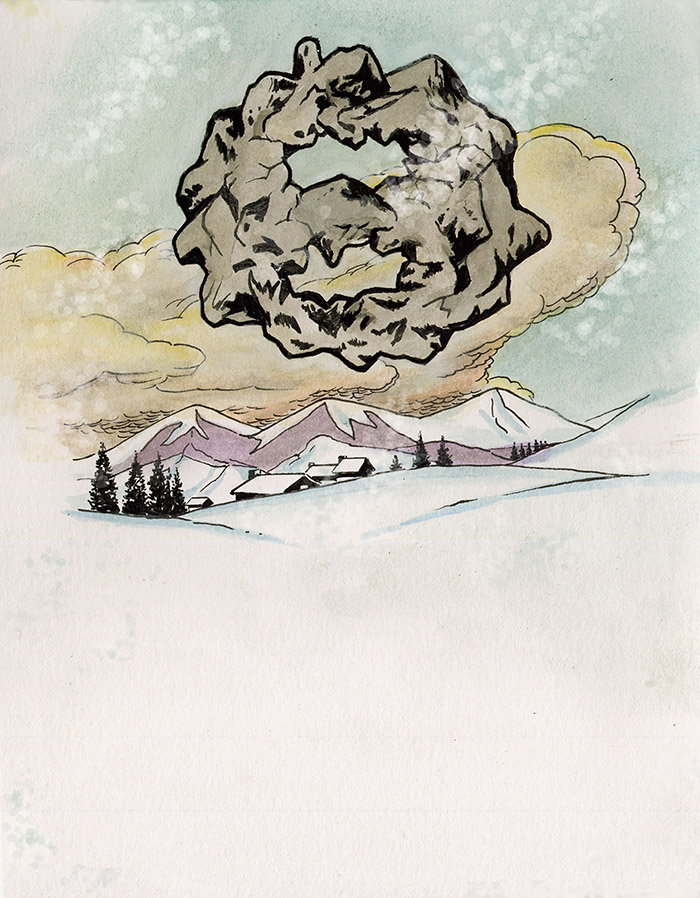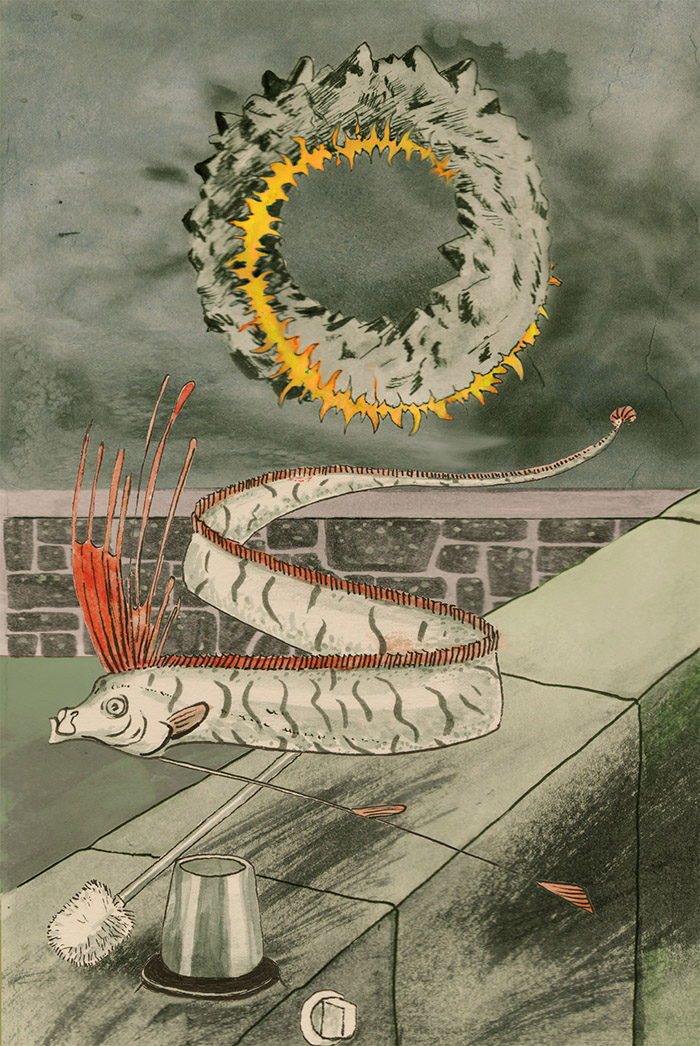Responses to As Above, So Below by The Surrealist Group of Stockholm
Weather and negative ontology by Mattias Forshage
A condensed image of whatever is out there is the weather. But is there something out there? What are the items we need to consider in our ontology, our lifeworld, our universe? Is there such a thing as the weather? And if there isn’t, is there such a thing as denial?
This is not intended to be paradoxical. But of course, to the human mind, explicitly denying something means voicing it, giving it a presence, suggesting an image of it, invoking it. Denying something very specific is always a way of rhetorically stepping up into omnipotence, de-inventing something that shouldn’t be there, assuming the right to claim that it is not there. And psychologically of course it is often a way of allowing yourself to fantasise about it without extending any rights to it. Except the right to be fantasised about, and therefore to exist… Denying something is also a way of suggesting an alternative world where this particular thing simply does not exist, and therefore in a sense creating that particular thread in the multiverse. One might say that ontological statements in real life are often instances of poetry, invoking new worlds.
Many a scifi story, and many a primitivist-environmentalist wet dream, concern the strategy of de-inventing the inventions of the contemporary world one by one. (A comic book story that made a big impression on me as a child with this theme was an old “golden age” DC Captain Marvel (Shazam) story, which I’ve never seen again. Searching for it now I can identify it as “The Day Civilization Went Backwards!” from 1941.) Clearly this is a poetic strategy, even in the cases where it is suggested by a political agenda. To be able to imagine a world where a certain item simply does not exist, and the consequences thereof, both in terms of pondering or fantasising about how things need to be altenatively arranged, and in terms of the very spiritual relief of not having to consider such a thing at all, is one of the aspects of poetic freedom and of everyday magic.
I’m aware I may be testing the patience of those who understood what I am talking about from the beginning, but I will give an example. Once I started a poem with the line “There is no such thing as glass”. It wasn’t an automatic line, it was a shout of anger from my everyday life which I felt inclined to explore some aspects of. At the time I was walking barefoot in the city a lot, and all the time people bothered me with their concerns that I might step in glass. Likely or unlikely as it may have been, it was definitely something that it was not interesting for me to consider in my walks. For me, there was no such thing as glass, worrying about minor cuts or even thinking about the existence as such of glass would be an uninteresting distraction from the discoveries of those walks. Surely, stepping into glass and cutting my feet would have been such a discovery, that would not have benefitted the least from my worrying about it beforehand. Glass would have suddenly sprung into existence, teleporting me between possible worlds. I had the power to not let glass populate my ontology while still acknowledging its crystal lingering in the dim background with all its immediate associations of refreshing drinks and bloody cuts and thousands of other things. Its transparency bordering on invisibility while still sparking off these fireworks of reflections. Living in the proverbial glasshouse, carrying out my business transparently but without any interest in the idiotic concerns of the petty pavement prefects, with the bliss of ignorance as one of the aspects of the twoedged weaponry of denial.
But such a pedestrian application of a basic poetic pluriverse metaphysics (parallel but not identical with the multiverse theory of the physicists) may or may not veer off into solipsistic fantasies but perhaps always tends to provoke a sadistic urge to ”reality check”. Sure, realities are lining up before us as cards in a deck, or even more like the branches of a bush, but there is always the alleged objective corrective, crude matter, uncontrollable circumstances, little bodily wishes, the goddamn weather. You step in glass, you get hungry, it is warm, it is cold, it rains. It is not even sadistic. Surrealism attracts a rather disparate spectrum of personalities, with a strong minority who like to think of spiritual adventure as one where you ignore the petty material circumstances, the dirty sidewalk and the puny body, but a majority who enjoys pointing out the potential marvels and the marvellous potentiality of not making such divisions, loving the dirt not because it’s dirty but because it’s actually full of openended strange suggestions and weird shapes and lifeforms.
Of all the things that can be denied, the one that it seems perhaps the least poetically liberating to come up with, is the weather. Still civilised life keeps stubbornly insisting that every day is business as usual, all the routines of work hours, opening hours, lunch hours, pub hours, appointments, traffic, meetings, sunday picnics, holidays, they should all be expected to follow the same detailed schedule regardless of weather and should all be available for detailed planning long ahead; especially in the cities people are even usually dressed in basically the same way regardless of temperature and precipitation, because the moments when you are actually exposed to the weather are often just the short runs between various indoors environments, between shops, offices, buses, trains and cars anyway. A certain degree of wreaking havoc with roads, tracks and vehicles is expected to be completely ignored, it is only certain extreme cases which are accepted as force majeure. But of course the businessmen are happy to sell umbrellas and sunscreen lotions and vacation tickets anytime, and the ideologists are happy to claim the weather as a metaphor for the economy so as to suggest that the latter is beyond political decisions and any other conscious human influence. While the totem pole in our midst keeps repeating with a robotic voice “There is no such thing as the weather” all the way up to the very point where not even the most stubbornly credulous can believe it anymore.
Yet still there is a vast popular interest in weather forecasts. Uncertain as they are, they nevertheless superimpose a certain structure on the mysterious ways of the big out there and will fulfill a variety of psychological needs. But it remains true that “you don’t need a weatherman to know which way the wind blows”. If you want to strike up a conversation with a stranger or a superficial acquaintance, or even a true friend just establishing rapport first, in many cultures the obvious option of an non-controversial and casual yet still deeply meaningful topic is the weather. Such conversations, if you just listen to them, with their relaxed and rather fatalistic summarising very grand themes, often balance on a tightrope between utter banalities and poetic truths. Of course, it’s not considered casual and therefore not polite to start saying these things about life in general or about one’s mental health or about the conditions of existence, so talking about the weather easily adopts the role of an allegory at the same time as it keeps concerning that which it speaks explicitly about. Since, you know, the weather is immensely interesting, regardless of whether one sees it as a baseline ambiance conditioning one’s life experience and possible behavior day by day, or perhaps as an expressionistic extension of the inner state with its storms and its statics, or as fluctuating between the two.
Poets have been called “friends of the weather”. A secret tribe walking among the regular population paying attention to atmospherical phenomena, feeling the warmth and the cold, the damp and the drought, the light and the darkness. Just like most people, but only somewhat more resistant to the idiotic civilised imperatives to ignore it (or to squeeze it into the grandmother dualism of all dry and warm weathers being “fine” and all cold or wet ones being “bad”). Seeing every heavy rain, every gale, every roar of thunder, every heatwave as a real drama, a state of emergency where relationships between people and commitment to duties are being somehow renegotiated. Where new images, new possible solutions and new worlds take shape. Surely, on a global level, weather varies much more in some places than others. In general, the lower the latitude, the less difference between seasons and the more predictable weather. But just like the cycle of night and day, the very tangibleness of the weather makes it an undeniable reminder of change and of the importance of the exterior circumstances at all times. The onslaught of rain, just like the darkness of night, cannot ever be forgotten just because it may occur in a clockwise fashion, and the experience of it will always assert itself. A reminder of reality. And therefore of the plurality of possibilities. What we call poetry. There is no such thing as the weather. There is just reality as such. With all these little flashlight images of natural disasters and utopian worlds, especially but not only where you are unable to tell them apart. These are the weathers. They don’t exist. Therefore they are the spirits we dance with in our daily lives.

As above, so below? by Kim Fagerstam
Emma Lundenmark
Red fox is climbing inside
was it there you left your gloves, dear
was it there your pale blue breath
reached the sky as a column of smoke in an uninhabited landscape
I hear you licking your mouth, even though you’ve never tasted food
I hear you whimpering, narrow as the night knocks my door
Loved fur, emaciated form, the one who stopped running, listen!
Red fox is climbing inside me, using its tongue as a ledge,
falling through layers of silence, only to dare the same leap again,
the same leap in the same body, the same silence as before.
Search for the openings or sink through melted skin, what would you prefer?
I hear your body fall, even though you’re smiling
I see your silence behind bars, listen!
Red fox is twisting, swirling
as she turns her cubs in the den to the sun
and she sighs, pleased, when they’re crawling back in
it’s hot in the silence
It’s not even silent anymore
there’s no diving-board beneath earth, you know
and you can not, you can’t even fall

Ika Österblad
Tension, eruptus and breaking wind. Microbes are found miles down in the earth’s crust and a wealth of different microbes dwell in the alimentary canal. Among them, as symbionts of numerous belching and farting mammals, methanogenic archaea; breaking forth cycles, cyclones, erosion, eclosion.
Niklas Nenzén

Float mount
To embody the powers of the sky, or weather, I returned to an old oneiric vision of a floating, self-contained stone planet over a snowy landscape. In a new sketch, also inspired by the call from Peculiar Mormyrid 8 and the ensuing discussions among the surrealist group of Stockholm, that planet was turned in on itself in a continuous movement as if trying to get away from, alternately approaching, its own fiery other side. To further animate the intuition that places act like beings, I invoked the giant oarfish (Regalecus glesne), vertical swimmer and splendid contemporary candidate for a natural sea-snake. In my depiction the giant oarfish takes on the attributes of the crowned Mesopotamian sky god Anu, which according to ancient legend, encloses the universe in itself and also, in a passus from the Sumerian epic of Gilgamesh that Jonas read aloud from, traverses the underground. Like its probable Greek counterpart Aion-Ouranus, Anu was castrated by his son in an obscure mythological battle for separating heaven and earth to enable the creation of mankind. Since the metaphor is real, there is little doubt that the stakes underlying the surrealist cut of the collage are equally as high — or low.
My two images can be seen as variants of the lemniscate (infinity eight) and the möbius band, two figures which were used by Jacques Lacan to explain the inner and outer aspects of the psyche, and how the emergence of the subject is faciliated through ‘a cut in the real’ (coupure). In a pre-cut möbius topology the subject “traverses the fantasy” without having to make a “mythical leap” from the inside to the outside, while the cut introduces a methodology, where an inspired interpretation implements an unforeseen idea of “two sides”. This, I would suggest, reflects surrealism’s understanding of the Hermetic credo “as above, so below”, when the correspondence between the material and the celestial is encoded as outer and inner materiality in both continuous and discontinuous transformation.
The shortest way to the other side’s weather, as suggested by Mattias Forshage´s methodological reflection, is to deny that there is a weather out there, while at the same time doubting this very act of denial. This double movement — arguably an Hegelian negation of the negation, pointing to a self-referential, dissolutive positive ground — could manifest concretely as a balcony. At least it did so in my second picture, since I designed a balcony solely for compositional reasons but then dreamed of one at night, as if it was the most important element of the image. I also dreamed that I was making a bed for someone to sleep on the lawn under the stars — maybe the origin of the idea of a balcony, and surely a preferred “positive ground” for vertical swimming.

Regalecus
